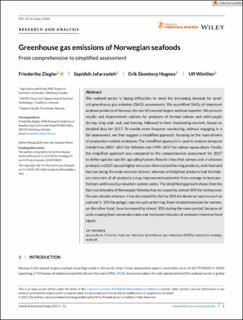| dc.description.abstract | The seafood sector is facing difficulties to meet the increasing demand for product greenhouse gas emission (GHG) assessments. We quantified GHGs of important seafood products of Norway, the world's second largest seafood exporter. We present results and improvement options for products of farmed salmon and wild‐caught shrimp, king crab, cod, and herring, followed to their dominating markets, based on detailed data for 2017. To enable more frequent monitoring, without engaging in a full assessment, we then suggest a simplified approach, focusing on the main drivers of production‐related emissions. The simplified approach is used to analyze temporal trends from 2007–2017 for fisheries and 1990–2017 for salmon aquaculture. Finally, the simplified approach was compared to the comprehensive assessment for 2017 to define species‐specific upscaling factors. Results show that salmon and crustacean products in 2017 caused higher emissions than cod and herring products, with feed and fuel use being the main emission drivers, whereas airfreighted products had the highest emissions of all products. Large improvement potential from average to best performers within each production system exists. The simplified approach shows that the fuel‐use intensity of Norwegian fisheries has increased by almost 50% for shrimp over the past decade whereas it has decreased for fish by 20% for demersal species such as cod and 5–10% for pelagic species such as herring. Feed‐related emissions for salmon, on the other hand, have increased by almost 30% during the same period, because of an increasing feed conversion ratio and increased inclusion of emission‐intensive feed inputs. | en_US |

